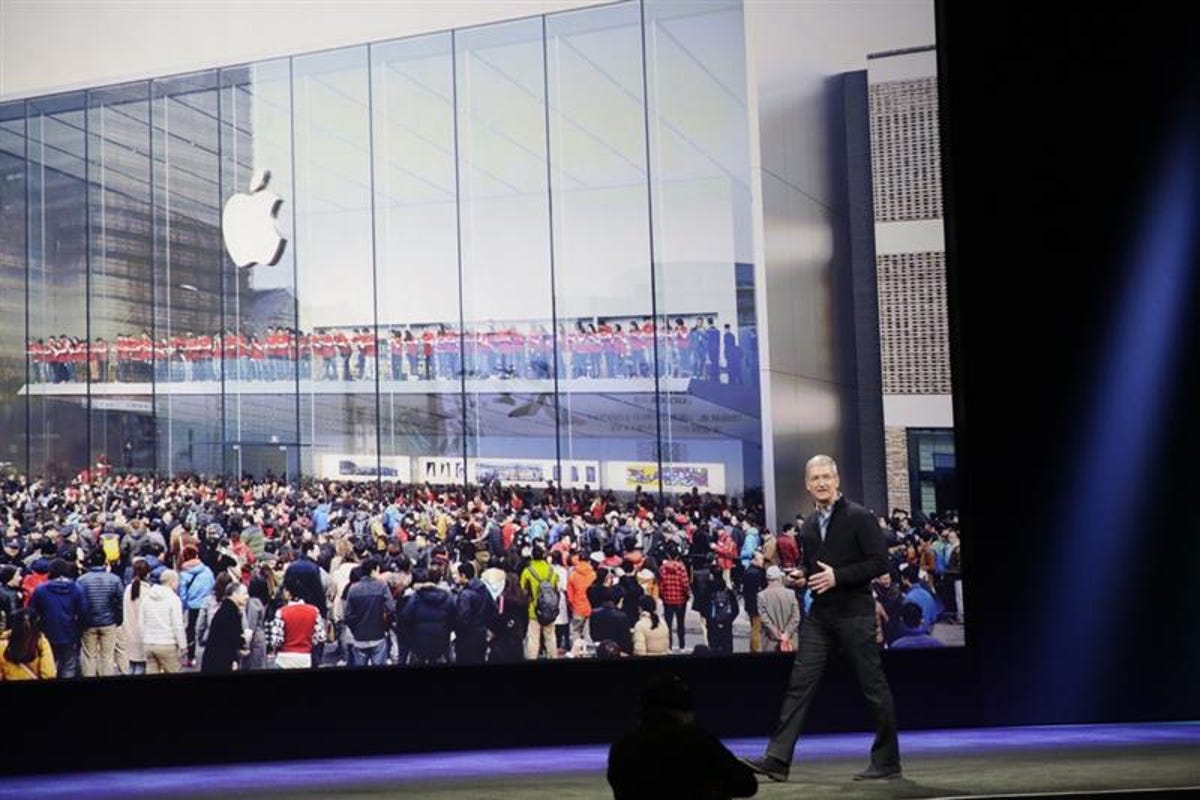
Tim Stevens/CNET
Apple CEO Tim Cook took the stage on Monday for his company’s “Spring Forward” press event. But rather than jump right into the expected details about the Apple Watch, he talked up his company’s success.
Cook kicked off the event with his company’s retail stores, saying that Apple has opened six stores in China in six weeks and has 453 retail stores worldwide. Over 120 million customers visited Apple’s retail stores in the fourth quarter, alone.
He then turned his attention to hardware, revealing that Apple has sold 25 million Apple TV units and just recently sold its 700 millionth iPhone since that device’s launch in 2007. Thanks in large part to the iPhone’s success, Apple Pay, the company’s mobile-payment platform, had expanded to over 2,500 banks, up from 6 banks when it launched. Apple Pay is available at over 700,000 locations worldwide, up from 200,000 when it launched late last year.
The comments come just weeks after Apple reported the highest quarterly profit for any publicly traded company — ever — because of strong iPhone sales. Driven by the new iPhone 6 line, Apple’s smartphone accounted for 70 percent of sales, as the company sold through 74.5 million units during the three-month period ended December 27. That’s 46 percent more devices than the record 51 million sold in the year-earlier quarter.
While the iPhone performed well during the period, iPad unit sales dropped 18 percent to 21.4 million, slightly below analysts’ predictions of 21.5 million. Revenue totaled $8.99 billion.
Apple also reported that it sold 5.52 million Macs, up from 4.84 million a year ago and higher than the 5.51 million projected by analysts. Macs accounted for 9.3 percent of sales, and revenue from the computers reached a record high of $6.94 billion.
Total sales for the period ended December 27 jumped 30 percent to $74.6 billion, well above the $67.69 billion projected by Wall Street.
Cook’s comments provided a curtain-raiser for an event expected to focus on the Apple Watch. For Apple, it’s key to expand beyond its current iPhone franchise. The company is more reliant on its smartphone than ever before. It has looked to Apple Watch and Apple Pay as new products with strong potential, and it also is exploring ways to revitalize its struggling iPad business.
The Apple Watch marks the company’s first new product category since the “magical” iPad in 2010. It’s also the first new push by the company under Tim Cook’s tenure. Cook had promised for over a year that Apple in 2014 would introduce iting new product categoriesbeyond its wildly successful smartphones, tablets and computers.
Cook, introducing the Apple Watch in September, called the smartwatch a “breakthrough” product. He described it as a “comprehensive” health and fitness device, walkie-talkie and remote control for the Apple TV streaming-box. Those factors alone set the Apple Watch apart from other smartwatches on the market, which tend to simply track steps, provide notifications, and run very basic apps.
But Apple went even further — creating what Morgan Stanley analyst Katy Huberty called a “Swiss Army knife” sort of wearable. It included an NFC (near field communications) chip in the watch to enable mobile payments. It put a haptic feedback engine in the device so that it vibrates when receiving an alert or a being given a direction in programs like Maps. Apple included a digital touch feature to allow two people to communicate quickly through taps, drawings, and by sharing their heartbeats.
The company also placed a big emphasis on design, making sure the watch is fashionable and something people actually want to wear. While at first glance it resembles Samsung’s Gear smartwatches and other wearables already on the market, it provides more ways the wearer can customize it. Apple will provide a range of bands in various materials — including leather and metal — so users can tailor the product to their style. And there likely will be bands from third-party vendors in the future, as well.
The Apple Watch comes in two sizes (42mm or 38mm) and three designs — the aluminum-cased Apple Watch Sport, stainless-steel-cased Apple Watch and the 18-karat-gold-cased Apple Watch Edition. The aluminum comes with silver or space gray options, while the stainless steel comes in its namesake color or a space black version. The gold watch is available in 18-karat yellow gold or 18-karat rose gold. There also are a variety of bands that can be easily swapped, including a Milanese loop of metal mesh with magnets, a leather band that auto-attaches, a segmented metal link band, a classic leather watch band, a leather loop band, and a more plasticized sport band in bright colors.
The entry device, the aluminum-and-glass Apple Watch Sport with plastic band, starts at $349. Apple hasn’t yet revealed pricing for its mid-range and high-end watches, but experts believe the 18-karat-gold Apple Watch Edition could climb to price levels associated with fine jewelry, such as $5,000 or above.
The devices must be paired with an iPhone, and are compatible with the iPhone 5 , 5C, 5S, 6, and 6 Plus. Sadly, earlier iPhones are excluded, as are other phone platforms like Google’s Android operating system and Microsoft’s Windows.
The Apple event is ongoing right now. Catch CNET’s live blog here.



